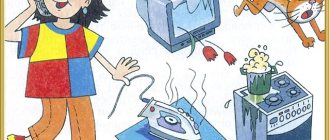Didactic material on teaching fire safety measures and rules
Didactic material is a special type of teaching aids, mainly visual, demonstrated by the teacher in front of the whole class (group). The use of didactic material helps to intensify the educational activities of students and save study time.
In the process of teaching fire safety measures and rules in preschool organizations and general education organizations, the following didactic material can be used:
— elements of fire protection systems for buildings and structures;
— primary fire extinguishing agents;
- individual protection means;
— fire and rescue equipment;
— didactic materials related to fire issues (books, printed materials (posters, coloring books, instructions, etc.), videos, filmstrips, audio files, etc.).
Evacuation rules
Acrid thick smoke during a fire can be more dangerous than fire. It reduces visibility, making evacuation difficult, and also poisons the respiratory tract. Therefore, instructions for children in case of fire teach them to take care of respiratory protection.
To do this, use any available material: scarf, T-shirt, towel. Soak the cloth in water and apply it to your face.
Smoke rises upward, so to get out of a burning room, crawl or on all fours.
After leaving the apartment, close the front door tightly to prevent the fire from spreading through the entrance and to prevent oxygen from entering the apartment.
The main task in an emergency is to save lives. Therefore, you should not waste time searching for and collecting valuables!
Organization of a classroom, fire safety corner
One of the most common emergencies is fire. As a rule, in extreme conditions people lose the ability to adequately respond to what is happening. Therefore, in order to avoid tragedy, it is necessary to inform people in advance about actions during a fire. This information should be visual, accessible and easy to remember. For this purpose, classes and fire safety corners can be created in preschool educational organizations and general education organizations. At the same time, their creation and functional content are not regulated by regulatory legal acts and normative documents.
The fire safety class can accommodate:
— elements of fire protection systems for buildings and structures;
— primary fire extinguishing agents;
- individual protection means;
— fire and rescue equipment;
— didactic materials related to fire issues (books, printed materials (posters, leaflets, instructions, etc.), videos, filmstrips, audio files, etc.).
One of the effective methods of achieving the goal of informing people about actions during a fire is to design and place a fire safety corner in a visible place with good traffic.
There are a variety of types, types, design options for fire safety corners, methods of printing them, methods of placement (floor-mounted, wall-mounted, mobile).
The fire safety corner should reflect the specifics of the organization’s activities and may contain both methodological and handout material.
The following information can be presented at the fire safety corner stands: evacuation plan, instructions on fire safety measures, liability for violation of fire safety requirements, procedures for action in case of fire, fire safety requirements, instructions on the use of primary fire extinguishing equipment, fire safety signs, etc. .
Examples of the design of a fire safety corner are presented in Figures 1 – 3.
Rice. 1. Example of design of a fire safety corner
Rice. 2. Example of design of a fire safety corner
Rice. 3. Example of design of a fire safety corner
Actions in case of fire in an apartment for children
Fires are often caused by the actions of children left without parental supervision. Therefore, the first lessons should begin with a discussion of preventive measures and fire safety rules for children.
It is important to explain to young children from an early age why they should not touch wires, sockets, electrical appliances, approach a lit stove or play with fire. Ignorance of basic rules leads to disastrous consequences.
Older children, when left at home alone, must understand the level of responsibility entrusted to them. And the tasks of parents include the following actions:
- Learn how to use electrical appliances correctly;
- talk about the dangers of playing with fire;
- Conduct instructions on the first actions in case of fire.
It is important to explain to children how to behave during a fire, and also to make sure that the child knows the rescue service numbers and his home address. This will help save time in an emergency when calling the fire brigade.
When leaving children at home alone, it is necessary to remove flammable substances and objects from their reach.
QUESTIONS FOR SELF-CONTROL
- In accordance with what regulatory document on fire safety is training in fire safety measures carried out?
- What document regulates the frequency of practical training on evacuating people from buildings of preschool educational organizations and general education organizations?
- Who monitors the organization of fire safety training for employees of preschool educational organizations and general education organizations in accordance with Order of the Ministry of Emergency Situations of Russia dated December 12, 2007 No. 645?
- What is the nature of training students in fire safety measures?
- The frequency of practical training on evacuating people from buildings of preschool educational organizations and general education organizations is?
- What information can be placed on the fire safety corner stands?
- What are the objectives of conducting practical training on evacuating people from buildings of preschool educational organizations and general education organizations?
- Should an evacuation plan be developed for buildings of preschool educational organizations and general education organizations?
- Who should report the discovery of a fire in the building of a preschool educational organization or general education organization to the fire department?
- What information must be reported to the fire department when a fire or signs of burning are detected?
- When does the process of evacuation of students and staff from the buildings of preschool educational organizations and general education organizations begin in case of fire?
- What actions does the staff of preschool educational organizations and general education organizations take after completing the fire evacuation process?
- What is taken into account when conducting fire safety training?
- What is the basis of fire safety training?
- Indicate the sequence of actions of staff, pupils and students of a preschool educational organization, general education organization upon detection of a fire or signs of combustion, which consists of the following elements: a) checking the presence of pupils, students, staff of a preschool educational organization, general education organization; b) collection at a predetermined place; c) fire warning signal; d) evacuation
Reminder of rules for handling electrical appliances
Today, almost all children know how to use a microwave, computer or iron. But errors in handling equipment often cause fires.
The use of electrical appliances should not be prohibited, but safety instructions are necessary:
- Turn off the device immediately after use.
- Do not leave heating equipment (iron, curling iron, electric oven) unattended.
- Make sure that there are no flammable materials near the heating elements.
- After unplugging the appliance, allow it to cool completely before removing it from sight.
- In case of any malfunction, immediately disconnect the device from the network.
- Under no circumstances should you repair electrical appliances yourself.
- It is not allowed to connect several devices to one outlet.
Fire safety rules for children, as well as the rules for using household appliances, must be instilled from early childhood.
How to behave in case of fire for children if there are no adults nearby
Children should know the signs that indicate a fire has started. Once you smell smoke, you can't ignore it. You need to go around your home and find a possible source of fire. If nothing is burning in the apartment, it is possible that the smell is coming from the street or from neighbors. Therefore, it is recommended to look out the window and onto the landing.
The child must know his neighbors in order to turn to them for help in a dangerous moment.
If the source of fire is found at home, you can begin to extinguish it only if the fire is small. To do this, use water, a thick blanket, sand, soda or earth. It is prohibited to extinguish electrical appliances with water!
How to put out a small fire
Knowing how to behave during a fire for children, you can adequately assess the situation and take the right actions. It is possible that a child can handle a small fire on his own, without calling emergency services.
- If an oven mitt or towel catches fire in the kitchen, throw it in the sink and turn on the water tap.
- Douse a fire in a trash can with water.
- It is prohibited to extinguish oil that flares up in a frying pan with water! This will cause it to splash in all directions and leave serious burns on the skin. In this case, cover the pan with a lid and turn off the burner.
- If electrical appliances or wiring catch fire, turn off the electricity. To extinguish the source, use dense natural material, earth or washing powder.
- If a fire appears on the balcony, extinguish it in the same way - using water, sand, earth or other non-combustible materials.
In case of a rapidly growing fire, direct all efforts to rescue, using the following reminder of behavior in case of fire.
LITERATURE
- Federal Law of December 21, 1994 No. 69-FZ “On Fire Safety”. - “Rossiyskaya Gazeta”, No. 3, 01/05/1995;
- Decree of the Government of the Russian Federation of April 25, 2012 No. 390 “On the fire safety regime.” - “Collection of Legislation of the Russian Federation”, 05/07/2012, No. 19, Art. 2415;
- Order of the Ministry of Emergency Situations of the Russian Federation dated December 12, 2007 No. 645 “On approval of fire safety standards “Training in fire safety measures for employees of organizations.” — “Bulletin of normative acts of federal executive authorities”, No. 13, 03/31/2008;
- Methodological recommendations for training in the field of civil defense, prevention and response to emergency situations and fire safety. (Approved by the Ministry of Emergency Situations of Russia on June 20, 2014). The document was not published;
- Methodological recommendations for organizing training for managers and employees of organizations. Fire safety briefing and fire-technical minimum. (Approved by the Ministry of Emergency Situations of the Russian Federation). – “Library of a labor protection engineer”, No. N 1 - 2, 2007;
- Methodological recommendations “Organization of training for the evacuation of personnel of enterprises and institutions in case of fire and other emergency situations” (Approved by the Chief State Inspector of the Russian Federation for Fire Supervision on September 4, 2007 No. 1-4-60-10-19);
- Ensuring fire safety of national economic facilities. Part 3. Organizational and technical measures. Under general ed. IN AND. Kozlachkova. – Minsk: “FOIKS”, 1998. – 317 p.;
- Sukhomlinsky V. A. I give my heart to children. — Fav. ped. cit.: in 3 volumes - M., 1979, vol. 1, p. 33.
- Internet resource https://ddt2mariinsk.ucoz.ru/index/pozharnajabezopas nost/0-16;
- Internet resource https://www.profi-ra.ru/agit/stend1/;
- Internet resource https://marina-tcherepanina.narod.ru/index/0-4.
What to do in case of fire for children
Unfortunately, no one is immune from critical situations. Therefore, in addition to preventive conversations, it is useful to talk about specific actions in the event of a fire. A reminder of the rules of conduct for children is as follows:
- In case of fire, call the fire department, give your name and address;
- quickly leave the apartment;
- ask neighbors for help;
- inform arriving firefighters about the location and source of the fire.
There is a separate list of actions that are strictly prohibited in case of fire:
- You cannot hide under the bed, in the closet, or any other places. This will make it difficult for the arriving fire brigade to search.
- It is prohibited to use the elevator to leave the building. If the power goes out in the house, the elevator will get stuck.
- A fire in an electrical appliance must not be extinguished using water.
- In case of fire, you should not open windows, as this will only intensify the fire.
If it happens that it is impossible to leave a burning room, you need to protect your respiratory tract from smoke with a cloth soaked in water. Using the water at your disposal, you can create a safe zone around yourself by pouring the liquid onto the floor. This will help buy time while waiting for the fire service.
To better understand the rules of behavior in case of fire, it is better to conduct a dialogue in a playful way, giving detailed examples.
What to do in case of a fire in the forest
School-age children can go with their class or friends on vacation to the forest. But this place cannot be called safe, because forest fires are considered a destructive natural disaster.
Therefore, when letting your child go into the forest, it is important to give him safety instructions.
- If the fire from the fire spreads to dry grass, it must be extinguished using branches, sand, clothing or water. At this stage it is important to prevent the flame from spreading.
- If it was not possible to cope with the fire, and the fire spreads further at speed, it is necessary to leave the fire zone, warning people oncoming about the danger.
- When fleeing a forest fire, you should take into account the direction of the wind and move towards it.
- After moving to a safe distance, call the Ministry of Emergency Situations.
Fire safety training is designed to save children's lives. Therefore, schools hold open lessons and evacuation drills, and fire behavior reminders are posted in prominent places. In turn, parents are obliged to take care of their children’s literacy from early childhood, to consider various situations and possible solutions to problems.
An educational cartoon will help you learn the material correctly:




